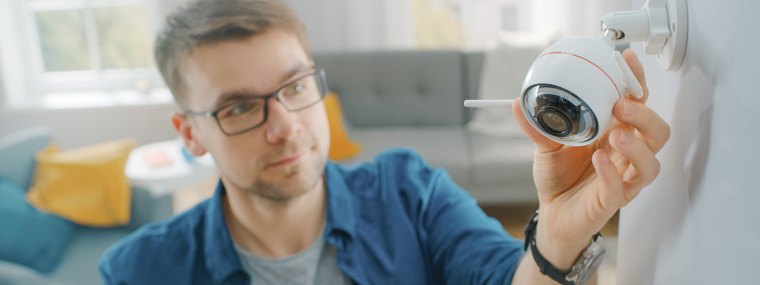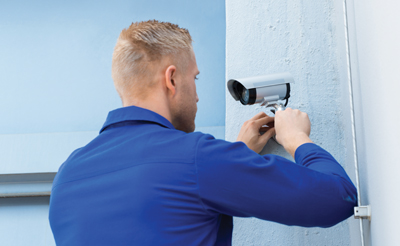
What You See Is What You Get
By Brad Higdon / Published June 2021

In today’s society, video has become attached to our lives in so many ways—through FaceTime, news media, home doorbells, dashboard cameras, video conferencing, and this list goes on. It is very important for a residential community to understand the advantages and pitfalls of security cameras. Experience has shown that many condominium associations install new security cameras when an event like vandalism, theft of personal property, or a medical emergency in the gym or pool occurs. These are just a few of several reasons to provide video surveillance, but I suggest looking at your association’s exposure before requesting a proposal without an outline of needs. Here is a suggestion for determining if cameras are right for your community’s needs. The video is a great investigating tool and accessory to completing your security plan, but before purchasing any system, consider the following.
- Is video right for your community? Maybe your community is small enough to be self-managed and self policed with little or no reason for video surveillance, but you may find that your property is increasingly being used by individuals that are normally allowed access to your property but may have alternative motives, including service companies, delivery services, or individuals accompanied by a realtor. You may also find unauthorized pedestrians and vehicle traffic on your property in order to access additional parking for nearby businesses, beaches, events, etc. Now may be the time for some security cameras.
- What are your video needs? Property, People, or Both—Before purchasing or upgrading your video surveillance system, a few items must be discussed and presented to a potential bidder. It is imperative that you have a plan with a directive on how to move forward on coverage, placement, analytics, environments, and clarity. You should inquire as to whether you have the capability of using your existing cables, or will you need to install new cabling? In this day and age, our electronics have come to include artificial intelligence (in lieu of human interaction) to start a plan of action, including calling the authorities, sending help, and restricting access. These features can be predictive, reactive, and continuous, providing a customized plan to your specifications. New camera technology allows for quicker system setup and intuitive operation, plus additional features like taking your temperature, overcoming intense backlighting issues, seeing in the dark, following moving subjects, subduing any camera shake with built-in image stabilization, and many other features too numerous to mention. New wireless technology allows full coverage throughout your community and across large open areas, and provides minimal changes to the aesthetics of your building.
- Is remote video surveillance part of your plan? With increased internet speeds, phone apps, and offsite video storage, the video market has exploded to include cloud-based services. Much like the doorbell cameras that many have today, you too can monitor off site from anywhere with an internet connection. These services could be provided with equipment with no additional cost or may come with a yearly fee. It is important to understand how your community may or may not use these features. Who will write your video policy? Who will administer and manage access to your system? This must be clear to all members of the community and may change when property managers, personnel, and/or board members change. This feature allows users to keep up with events from the surveillance site, even from other locations. The software offers easy access to multiple systems, which includes live view and recorded playback options from one application. Your site may include front gate, multiple buildings, lobbies, pools, beach clubs, tennis courts, parking lots, etc. The software allows for customizable video configuration, which may include all buildings’ front doors on one video display and all buildings’ elevators on another display, as an example. The customization is user defined.
- Do you have the need for system integration?Camera systems can now be truly integrated for multiple tasks, almost seamlessly. Some basic integration can add value while creating a more efficient environment—turning on and off lights when rooms are occupied or left, providing energy savings; regulating air conditioning settings based on occupancy; and integration into a building management system, including changing camera recording features to be more suitable to your building’s changing demands (example: night time recording may include exterior cameras on continuous recording and daytime recording may be provided on motion sensing only, saving recording space). Vehicle access control cameras allow you to authorize entry and exit to pre-authorized individuals through license plate recognition instead of presenting credentials at a card reader. Facial recognition cameras are becoming widely used for a secondary means of verification for access to sensitive areas. These cameras can also be integrated with point of sale, allowing you to view real time transactions overlaid on your security cameras as they are processed, or active card data by individuals with video (example: when residents enter front door, a video will be recorded and the actual authorization through access software will be overlaid on video for current or future review.) Staff timekeeping theft has been an increasing concern for employers, and with video as part of your timekeeping process, you can save thousands of dollars and remove any doubt when it comes to timekeeping fraud.
- Be aware of pitfalls of CCTV systems—There are very few pitfalls in having cameras; however, you should consult a professional for the proper application when it comes to your community. Improperly designed camera systems may provide a false sense of security under the wrong conditions for your residents, and selective coverage may not tell the entire story when reconstructing an event.
In our daily lives we are overwhelmed with video evidence on our news broadcasts, social media, and digital news media, thus proving that video is here to stay; and it has become more relevant as videos are replacing the written word. Videos may provide a solid investigative tool, but more importantly they provide a pro-active approach to preservation of life and property.
Now is a good time to start looking into more enhanced security for your community. This article should help lay the groundwork for your future needs, whether it be a housing community or a high-rise. The facts are the same. A pro-active approach can lessen the cost of liability and ensure your residents’ security needs are met. It is important to put the right technologies in place to drive efficiencies and value for the owners and operators of your building, while creating the best possible quality of life for your residents. Buildings that keep up with technology will lead the way with better safety and security for their community.
Brad Higdon
President/CEO, Bass-United Fire & Security Systems
Brad Higdon started Bass-United Fire & Security Systems in 1977 as a sole employee, and over the past 43 years he has grown the business into one of largest independently owned life-safety providers in South Florida. As the President and CEO, he carries the highest accreditations in the industry, which include State Fire Alarm Electrical license and State Fire Sprinkler Contractor license. Brad is factory certified on most fire alarm brands in the industry, along with holding a NICET Level IV Fire Alarm and NICET Level II Fire Sprinkler certification. He has built a company that continually delivers the solutions customers count on to protect their people and property with his dedicated staff, and his expertise and experience have afforded Bass-United many unique installation opportunities. www.bassunited.com.





